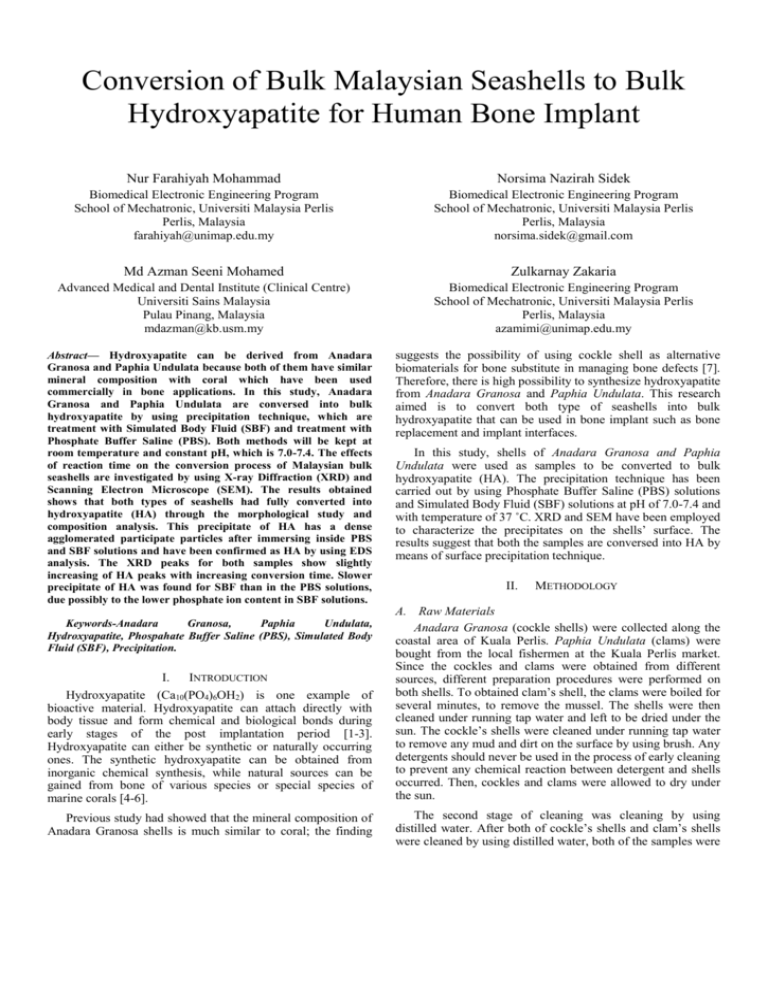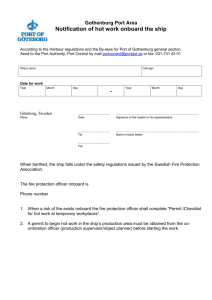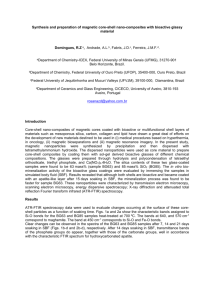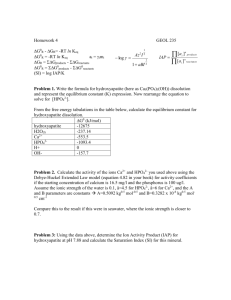
Conversion of Bulk Malaysian Seashells to Bulk
Hydroxyapatite for Human Bone Implant
Nur Farahiyah Mohammad
Norsima Nazirah Sidek
Biomedical Electronic Engineering Program
School of Mechatronic, Universiti Malaysia Perlis
Perlis, Malaysia
farahiyah@unimap.edu.my
Biomedical Electronic Engineering Program
School of Mechatronic, Universiti Malaysia Perlis
Perlis, Malaysia
norsima.sidek@gmail.com
Md Azman Seeni Mohamed
Zulkarnay Zakaria
Advanced Medical and Dental Institute (Clinical Centre)
Universiti Sains Malaysia
Pulau Pinang, Malaysia
mdazman@kb.usm.my
Biomedical Electronic Engineering Program
School of Mechatronic, Universiti Malaysia Perlis
Perlis, Malaysia
azamimi@unimap.edu.my
Abstract— Hydroxyapatite can be derived from Anadara
Granosa and Paphia Undulata because both of them have similar
mineral composition with coral which have been used
commercially in bone applications. In this study, Anadara
Granosa and Paphia Undulata are conversed into bulk
hydroxyapatite by using precipitation technique, which are
treatment with Simulated Body Fluid (SBF) and treatment with
Phosphate Buffer Saline (PBS). Both methods will be kept at
room temperature and constant pH, which is 7.0-7.4. The effects
of reaction time on the conversion process of Malaysian bulk
seashells are investigated by using X-ray Diffraction (XRD) and
Scanning Electron Microscope (SEM). The results obtained
shows that both types of seashells had fully converted into
hydroxyapatite (HA) through the morphological study and
composition analysis. This precipitate of HA has a dense
agglomerated participate particles after immersing inside PBS
and SBF solutions and have been confirmed as HA by using EDS
analysis. The XRD peaks for both samples show slightly
increasing of HA peaks with increasing conversion time. Slower
precipitate of HA was found for SBF than in the PBS solutions,
due possibly to the lower phosphate ion content in SBF solutions.
Keywords-Anadara
Granosa,
Paphia
Undulata,
Hydroxyapatite, Phospahate Buffer Saline (PBS), Simulated Body
Fluid (SBF), Precipitation.
I.
INTRODUCTION
Hydroxyapatite (Ca10(PO4)6OH2) is one example of
bioactive material. Hydroxyapatite can attach directly with
body tissue and form chemical and biological bonds during
early stages of the post implantation period [1-3].
Hydroxyapatite can either be synthetic or naturally occurring
ones. The synthetic hydroxyapatite can be obtained from
inorganic chemical synthesis, while natural sources can be
gained from bone of various species or special species of
marine corals [4-6].
Previous study had showed that the mineral composition of
Anadara Granosa shells is much similar to coral; the finding
suggests the possibility of using cockle shell as alternative
biomaterials for bone substitute in managing bone defects [7].
Therefore, there is high possibility to synthesize hydroxyapatite
from Anadara Granosa and Paphia Undulata. This research
aimed is to convert both type of seashells into bulk
hydroxyapatite that can be used in bone implant such as bone
replacement and implant interfaces.
In this study, shells of Anadara Granosa and Paphia
Undulata were used as samples to be converted to bulk
hydroxyapatite (HA). The precipitation technique has been
carried out by using Phosphate Buffer Saline (PBS) solutions
and Simulated Body Fluid (SBF) solutions at pH of 7.0-7.4 and
with temperature of 37 ˚C. XRD and SEM have been employed
to characterize the precipitates on the shells’ surface. The
results suggest that both the samples are conversed into HA by
means of surface precipitation technique.
II.
METHODOLOGY
A. Raw Materials
Anadara Granosa (cockle shells) were collected along the
coastal area of Kuala Perlis. Paphia Undulata (clams) were
bought from the local fishermen at the Kuala Perlis market.
Since the cockles and clams were obtained from different
sources, different preparation procedures were performed on
both shells. To obtained clam’s shell, the clams were boiled for
several minutes, to remove the mussel. The shells were then
cleaned under running tap water and left to be dried under the
sun. The cockle’s shells were cleaned under running tap water
to remove any mud and dirt on the surface by using brush. Any
detergents should never be used in the process of early cleaning
to prevent any chemical reaction between detergent and shells
occurred. Then, cockles and clams were allowed to dry under
the sun.
The second stage of cleaning was cleaning by using
distilled water. After both of cockle’s shells and clam’s shells
were cleaned by using distilled water, both of the samples were
allowed to dry under the sun. Then, they were dry in the
incubator for one day with a temperature of 50˚C. Lastly,
samples were sterilized by using autoclave.
B. Preparation of PBS and SBF solutions
The PBS and SBF solutions were prepared according to the
conditions below:
Only plastic containers were used such as
Polyethylene (PE) beakers with smooth surface and
without any scratches.
Samples were retrieved out from PBS and SBF
solution after 2, 7, 14 and 17 days of immersion.
After cleaning, samples were dried in a desiccators
without heating because of their material properties
which will be unstable under conditions of heat.
C. Preparation of PBS
PBS solutions were prepared by dissolving PBS tablet
inside 100 ml of distilled water. The pH of the solution should
be maintained at 7.20±0.01 at 25 ˚C. The pH of the solution
was monitored by using pH meter.
incident radiation. The XRD peaks are recorded in 2θ range
of 20-80˚.
Mixture
A
B
TABLE I.
Order
1
2
3
4
1
2
3
4
III.
REAGENTS FOR SBF SOLUTIONS
Reagent
Amount (g)
1.5mM MgCl2.6H2O
0.304
2.5mM CaCl2
0.2775
136.8mM NaCl
7.995
3.0mM KCl
0.223
0.5mM Na2SO4
0.07
1.0mM K2HPO4.3H2O
0.2282
4.2mM NaHCO3
0.35
(HOCH2)3(NH2),Tris
6.056
RESULTS AND DISCUSSIONS
A. SEM Analysis
Fig. 1 shows the result of surface morphology analysis for
Anadara Granosa after immersed in PBS solutions for 14 and
17 days. Fig. 2 shows the result of surface morphology analysis
for Paphia Undulata before and after immersed in the PBS
solutions with different period of immersion.
Samples were submerged inside the solutions after the pH
was successfully stabilized. All samples need to be totally
submerged inside solution. Beakers that contain samples of
cockle shells were labelled as set A and beakers contained
samples of clam shells as set B. Then, all beakers were place
inside an incubator to maintain temperature of 37 ˚C.
D. Preparation of SBF
SBF was prepared according to manual prepared by Dr. Md
Azman Seeni Mohamed, senior lecturer and head of Natural
Product Cluster from University Science of Malaysia (USM)
and the article from Kokubo and Tadama [15]. Table 1 showed
an appropriate amount of reagents used to prepare one litre of
SBF solution. Mixture B was prepared first, followed by
mixture A. The temperature of mixture B was set at 37 ˚C and
pH at 7.25. Temperature of mixture B was regulated by using
water bath, while the pH was monitored by using pH meter.
Reagents were added, one after another, ensuring complete
dissolution of earlier reagent. HCL is added to maintain pH of
the solution at 7.25.
Samples were submerged inside the solutions after the pH
and temperature was successfully stabilized. All samples need
to be totally submerged inside solution. Beakers that contain
samples of cockle shells were labelled as set A2 and beakers
contained samples of clam shells as set B2. Then, all beakers
were place inside an incubator to maintain temperature of 37
˚C.
E. Characterization of Precipitates
SBF The surface morphology and microstructure of
clamshells and cockles were study by using Scanning Electron
Microscope (SEM).
XRD patterns are recorded with a Bruker AXS Germany
make X-ray Diffractometer, having CuKα (λ=1.5405 Å)
Figure 1. SEM images of Anadara Granosa; (a) 7days, (b) 17 days
Figure 2. SEM images of Paphia Undulata; (a) 7days, (b) 17 days
Surface morphology for Anadara Granosa and Paphia
Undulata after immersed in the SBF solutions also show the
same characteristic as Anadara Granosa and Paphia Undulata
immersed in PBS solutions. It can be observed that the number
of tiny agglomerated apatite particles increases with increased
immersion times. Based on EDS analysis, it can be observed
that Calcium elemental composition in weight percentage
increase with time and reached maximum value after 7 days.
This result is in agreement with Ni and Ratner [8].
However, for both samples, only few dispersed precipitates
can be observed on the surface after immersion period of 17day, which was consistent with the result of the elemental
composition analysis. The SEM images show a dense
agglomerated precipitate, which is in agreement with Chavan
et. al. and Barakat et. al. researched [9-10]. Chavan et. al
reported, a dense apatite layer is observed on porous bioactive
materials from SBF solution, but the formation of porous
interlinked apatite layer from SBF is rarely reported [9].
The SEM images of the surface of Anadara Granosa and
Paphia Undulata after immersed in SBF solutions with
different immersion periods show a little agglomerated
precipitation on the surface when compared to the SEM images
of the surface of Anadara Granosa and Paphia Undulata after
immersed in PBS solutions with different immersion periods.
One of the possible reasons for this slower rate of precipitation
inside SBF solutions compared with PBS solutions is the lower
content of the phosphate ions, HPO24-, in SBF solution [11].
B. XRD Analysis
Fig. 3 shows the XRD patterns obtained from Anadara
Granosa before and after immersing in SBF solutions for
different immersing periods. Fig. 4 shows the XRD patterns
obtained from Paphia Undulata before and after immersing in
SBF solutions for different immersing periods.
consistent with the result obtained from EDS analysis. One
possible reason for the slight increment of HA peaks is delay in
recording. This delay could have resulted in the interaction of
the decomposed shells with the atmosphere to form carbonate
again. The shells’ surface could also contain organic matter and
impurities in addition to calcium carbonate, which sometimes
hinder the conversion into HA.
There is also a high peak of CHA for samples immersed
inside PBS and SBF solutions, which is closely matched with
the International Central Diffraction Data (ICDD), Powder
Diffraction File (PDF) No: 19-0272. Carbonate can incorporate
into apatite and substitute for PO4 and OH in the apatite crystal
structure and subsequently change its properties [12]. This
finding is in agreement with reports that the growth of HA in
SBF solutions results in the incorporation of sodium and
magnesium, it may thus be concluded that the solid
precipitation of HA in SBF solutions consists of carbonate
substituted HA [13]. The rate of tissue bonding appears to
depend on the rate of CHA formations [14]. This leads to a
new founding, which CHA seems to be a promising material
for bioresorbable bone substitution.
IV.
Figure 3. XRD patterns of Anadara Granosa before and after immersing in
SBF solutions with different periods.
Main peaks: 1.Aragonite, 2.HA, 3.CHA, 4.DCPD
CONCLUSION
This study demonstrated that the possibility to derived bulk
HA from bulk Malaysian seashells for human bone implant.
XRD shows the present of HA peak and high peak of CHA
after soaking in PBS and SBF solutions. This contributed to the
new finding of CHA, which is more similar to bone since bone
is
composed
essentially
of
carbonated-substituted
hydroxyapatite (CHA) [3]. Therefore, further studies should be
working on deriving CHA from Malaysian seashells.
Futhermore, SEM shows that the shells’ surface is covered by
HA and EDS data is consistent with these observations.
Finally, the mechanism of this surface transformation can be
explained as a dissolution-precipitation.
ACKNOWLEDGMENT
My greatest appreciation goes to my supervisor and final
year project colleagues. Not forgetting staffs from School of
Material, School of Bioprocess and School of Environmental
Engineering for endless guidance. Finally, relatives and friends
for companionship and motivation.
REFERENCES
[1]
[2]
Figure 4. XRD patterns of Paphia Undulata before and after immersing in
SBF solutions with different periods.
Main peaks: 1.Aragonite, 2.HA, 3.CHA, 4.DCPD
XRD patterns after immersing inside SBF solutions (Fig. 2
and Fig. 3) and after immersing inside PBS solutions, clearly
indicates the formation of a new phase resulting from the
precipitation process. The XRD patterns for HA, have a
slightly increase with increase of immersion periods, this is
[3]
[4]
B. Basu and S. Nath, "Fundamentals of Biomaterials and
Biocompactibity," in Advanced Biomaterials: Fundamentals, Processing
and Applications, B. Basu, D. S. Katti, and A. Kumar, Eds. New Jersey:
John Wiley & Sons Inc., 2009, pp. 3-18.
J. S. Temenoff and A. G. Mikos, Biomaterials, The intersection of
Biology and Materials Science. New Jersey: Pearson Prentice Hall,
2008.
B. Ben-Nissan and G. Pezzotti, "Bioceramics: An Introduction," in
Engineering Materials for Biomedical Applications, T. S. Hin, Ed.
Singapore: World Scientific Publishing Co., 2004, pp. 6.1 - 6.36.
U. Meyer, J. Handschel, H. P. Wiesmann, T. Meyer, H. P. Wiesmann,
and U. Meyer, "Biomaterials," in Fundamentals of Tissue Engineering
and Regenerative Medicine: Springer Berlin Heidelberg, 2009, pp. 457467.
[5]
M. Neumann and M. Epple, "Composites of Calcium Phosphate and
Polymers as Bone Substitution Materials," European Journal of Trauma,
vol. 32, pp. 125-131, 2006.
[6] G. Jayaswal, S. Dange, and A. Khalikar, "Bioceramic in dental implants:
A review," The Journal of Indian Prosthodontic Society, vol. 10, pp. 812.
[7] P. N. Kumta, "Chapter 18: Ceramic Biomaterials," in An Introduction to
Biomaterials, S. A. Guelcher and J. O. Hollinger, Eds. New York: CRC
Press, 2006, pp. 311-340.
[8] M. Ni and B. D. Ratner, "Nacre surface transformation to hydroxyapatite
in a phosphate buffer solution," Biomaterials, vol. 24, pp. 4323-4331,
2003.
[9] P. N. Chavan, M. M. Bahir, R. U. Mene, M. P. Mahabole, and R. S.
Khairnar, "Study of nanobiomaterial hydroxyapatite in simulated body
fluid: Formation and growth of apatite," Materials Science and
Engineering: B, vol. 168, pp. 224-230.
[10] N. A. M. Barakat, M. S. Khil, A. M. Omran, F. A. Sheikh, and H. Y.
Kim, "Extraction of pure natural hydroxyapatite from the bovine bones
[11]
[12]
[13]
[14]
[15]
bio waste by three different methods," Journal of Materials Processing
Technology, vol. 209, pp. 3408-3415, 2009.
M. Asada, Y. Miura, A. Osaka, K. Oukami, and S. Nakamura,
"Hydroxyapatite crystal growth on calcium hydroxyapatite ceramics,"
Journal of Materials Science, vol. 23, pp. 3202-3205, 1988.
X. Lu and Y. Leng, "Theoretical analysis of calcium phosphate
precipitation in simulated body fluid," Biomaterials, vol. 26, pp. 10971108, 2005.
N. Spanos, D. Misirlis, D. Kanellopoulou, and P. Koutsoukos, "Seeded
growth of hydroxyapatite in simulated body fluid," Journal of Materials
Science, vol. 41, pp. 1805-1812, 2006.
J. Chevalier and L. Gremillard, "Ceramics for medical applications: A
picture for the next 20 years," Journal of the European Ceramic Society,
vol. 29, pp. 1245-1255, 2009.
T. Kokubo and H. Takadama, "How useful is SBF in predicting in vivo
bone bioactivity?," Biomaterials, vol. 27, pp. 2907-2915, 2006.









